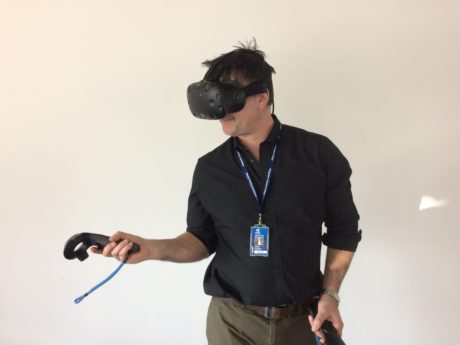Last week I was down at Bridgwater and Taunton College to check out the tools Stefan Cecchini and his colleagues are going to be using to deliver a revolutionary new engineering degree curriculum that aims to be entirely inquiry-led. There for the first time I tried out a virtual reality (VR) training environment. I put on the VR headset and gloves, and this is what happened (that’s Stefan, by the way wearing the VR gear).
I put on the equipment and find myself in a room where I can choose from three different scenarios displayed on a wall-mounted panel. The scenarios are: confined spaces, flow loop and lifting operations. I use my hand to select the confined spaces scenario.
Immediately I am teleported into a locker room. There are various pieces of personal protective equipment (PPE) on the benches. I see a clipboard on the bench and pick it up; I read a briefing about what PPE I need to wear to enter the confined space. I literally crouch down, pick up a boot and put it on. I put on the rest of the PPE and as I look down at myself in the virtual world, I can see that I am now wearing the PPE.
I walk over to the door leaving the locker room and I enter a corridor where the lighting is dim and I can see smoke emerging from around the corner. I walk forward, turn the corner. The smoke becomes thicker and there is water flooding the floor. I advance round two more corners until I reach a room where a motor unit is on fire. Opposite me I see a fire extinguisher. I pick it up, check it is the right kind of extinguisher for that fire, and then turn to the fire, and I put it out.
The fire extinguished I try to find the source of the flooding water. It appears to be seeping from under a door to an adjacent room. I try to open the door but I can see through its window that there is something blocking it on the other side. I spot that there is a ventilation hatch that I might be able to climb through at floor level, but it is held shut with screws. I walk back to the locker room, find a screwdriver and return to the hatch. I crouch down on the ground and remove the screws and the ventilator screen. I get down on my hands and knees and crawl through the hatch.
(At this point, to anyone observing me in the real world, they would see me down on my hands and knees, crawling on the classroom floor wearing a headset and holding two triggers, but to me inside the virtual world it felt very convincing).
Once through the hatch I find the controls for a bilge pump and I run it until the water is fully drained from the floor. I climb back through the hatch, return along the corridor to the locker room, whereupon I am told that I have successfully completed the ‘confined spaces’ exercise.
I take off the headset and I realise I have completely lost all sense of direction, and for a moment forget where I am.
The experience really was mind blowing. Even though the graphics looked like a simulation, they were convincing enough that I suspended my disbelief. Talking to Stefan afterwards he explained that this is what he is trying to do, to create an environment in which the learners can let go, at which point they are in a state in which really deep learning can take place.
Up until that experience I have been somewhat agnostic about VR. I saw the potential applications but was concerneed that the experience would not be good enough to trick our embodied cognition circuits into thinking this was real. Now my mind is changed and I am now thinking how much more of the training that I am involved with (Constructionarium, Big Rig and the Get It Right Initiative) could be enhanved through a VR experience.
Watch this space. (btw I am writing a report at Think Up about the new curriculum for engineering teaching, due out later this month. I’ll link to it here when it is ready).




Murtaza Rizvi
Hi Oliver,
Thanks for sharing this, so interesting to hear a first hand experience about VR and its uses for creating nuclear working environment. Cant wait to hear more about how your training develops and prepares you for a real world scenario
mazda
Thanks for that. When we have finished writing up the report, of which this first-hand account is part, I will add it to this thread so you can learn more about it. O